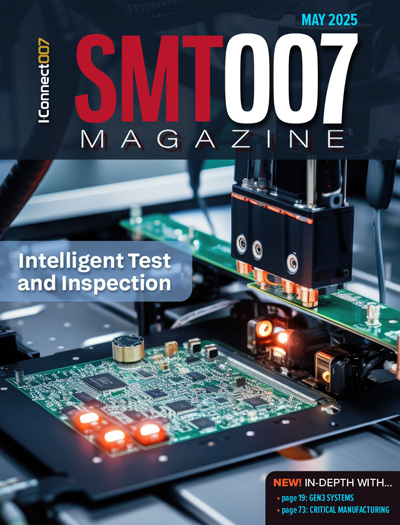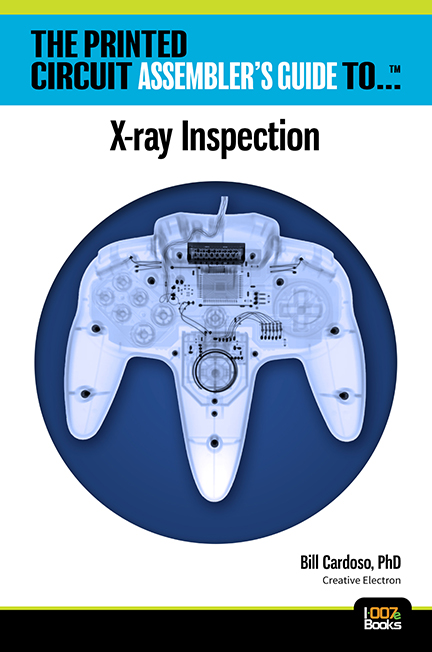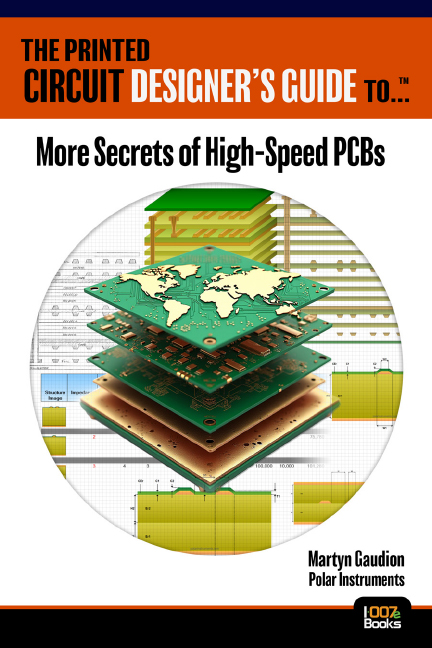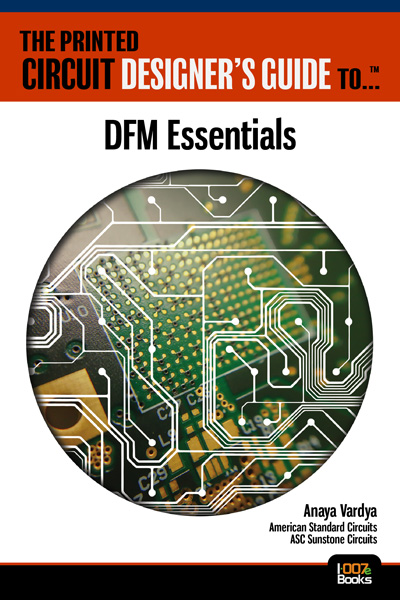-

- News
- Books
Featured Books
- smt007 Magazine
Latest Issues
Current Issue
What's Your Sweet Spot?
Are you in a niche that’s growing or shrinking? Is it time to reassess and refocus? We spotlight companies thriving by redefining or reinforcing their niche. What are their insights?

Moving Forward With Confidence
In this issue, we focus on sales and quoting, workforce training, new IPC leadership in the U.S. and Canada, the effects of tariffs, CFX standards, and much more—all designed to provide perspective as you move through the cloud bank of today's shifting economic market.

Intelligent Test and Inspection
Are you ready to explore the cutting-edge advancements shaping the electronics manufacturing industry? The May 2025 issue of SMT007 Magazine is packed with insights, innovations, and expert perspectives that you won’t want to miss.
- Articles
- Columns
- Links
- Media kit
||| MENU - smt007 Magazine
Latest Articles
From Participant to Volunteer to Leader: Matt Smith on the IEEE Rising Stars Conference
Matt Smith is one of the volunteer organizers for the IEEE Rising Stars Conference. As if that’s not enough, Matt also is an example of the impact this program can have on a young professional. In this interview, Matt provides an overview of the programs and what the conference strives to create for the attendees.
Eileen Hibbler and Jason Emes on Improving the West Penn SMTA Chapter
At the recent West Penn SMTA Expo, Eileen Hibbler, a chapter support specialist at SMTA, and Jason Emes, the current president of the West Penn SMTA Chapter, discuss ways to improve meeting attendance and develop a new slate of chapter officers.
Innovative Battery and Pressure Sensor Technologies
Tracy Liu is the director of R&D of the Nano and Advanced Materials Institute (NAMI) in Hong Kong. In an interview with I-Connect007, Liu talked about NAMI and discussed a number of battery and pressure sensor technologies being developed by the institute for licensing.
Preparing to Enter the Workforce With PCB Design Experience
Nolan Johnson recently spoke with Alex Burt, a computer engineering student at George Fox University, at a well-attended college career fair on the GFU campus in Newberg, Oregon. In the interview, Alex discusses his PCB classwork, challenges of design, and how it has impacted his internship experience as he prepares to enter the workforce upon graduation in the spring semester of 2019.
Tips & Tricks: Water Contamination and Flux Expiry
Solder joints that form properly are not expected to exhibit reduced reliability. However, a higher number of defects created tends to lead to a higher chance that defective connections escape detection through inspection and functional testing, and that’s not a risk to be taken lightly.
DSG: Breaking Ground on the Smart Factory Revolution
Mauro Dallora leads the I-Connect007 team through the Dongguan Somacis Graphic (DSG) PCB Co. Ltd. facility in China, lays out the company’s strategy for becoming an Industry 4.0 smart factory, and explains the current ongoing major expansion. Read about various topics in this factory tour and interview.
U.S. Tax Law Boosts Growth, But Uncertainties Loom
Monday, April 15 was the deadline for millions of Americans to file their income tax returns, so this is a good time to review the Tax Cuts and Jobs Act of 2017 (TCJA) as well as the current tax policy landscape and how these rules are affecting the electronics industry.
A Working Definition of Automation
Automation in a working context means more than just automatic machinery. Machinery implies mechanization. Automation also means the system information directs and controls people, materials, and machines. This concept is also known as systemization. Therefore, automation is made up of two components: mechanization (material flow) and systemization (information flow). Find out more.
A Young Engineer’s Perspective
Jeffrey Diament, a recent Princeton University graduate and an engineering associate from sensor manufacturer Instrumems, talks about the company’s nanowire sensing platform that can measure velocity, temperature, and humidity. Being his first career job out of college, Diament discusses his experience on the hardware and manufacturing side of things and offers advice to other young professionals.
RTW IPC APEX EXPO: IPC Global Government Relations Initiatives and Updates
IPC VP of Global Government Relations Chris Mitchell discusses with Judy Warner the association’s initiatives such as the IPC Workforce Champions, the skills gap analysis, and how IPC plans to advocate for the industry and grow the supply chain in North America and around the world.
Tips & Tricks: Humidity Level for Electronics Assembly
Low relative humidity (RH) can allow for higher static charges to build on objects. It can also affect solder pastes, especially OR-class pastes, and this can reduce print performance and stencil life. Read on to find out what level of RH you need for your assembly facility.
Building a Smart Factory Supply Line
I-Connect007 recently toured Victory Giant Technology (VGT) Co. Ltd. in Huizhou, China—one of China’s largest PCB producers. Currently, VGT generates about US$500 million in annual sales, and have plans to reach $1.5 billion in the coming years. Read more to find out VGT's expansion plans and strategies for growth.
IPC Working to Revive Lead-Free R&D in High-Reliability Sectors
Ask yourself the following question: Why is it that the aerospace, defense and high performance (ADHP) electronics sectors remain reliant on lead solders and components even as the commercial sector has largely phased out their use?
IEEE Rising Stars Conference Founder: Empowering Young Professionals
Held each year in Las Vegas on the weekend preceding CES, the IEEE Rising Stars Conference is rapidly establishing itself as a model program for developing leadership, networking, and aptitude in navigating an organizational structure in technical students and young professionals. Michael Andrews, an IEEE Senior Life member, serial entrepreneur, and founder of the IEEE Rising Stars Conference, tells us more.
Which IPC-A-610 Class is Best for Your PCBA?
For many EMS providers, IPC-A-610 is the agreed standard to define what's acceptable and what's not in the world of PCBA production. As an OEM, it's important that you're clear on the basic principles that separate those classes so that you have a clear and realistic expectation of what the results are going to be.
Kelly Dack at IPC APEX EXPO: The Attendees Speak!
During IPC APEX EXPO, Guest Editor Kelly Dack and the I-Connect team roamed the show floor, recorders in hand. They asked various attendees for their impressions of the show, and any new tools and technology that may have caught their attention. These are their stories.
WPC's Standardized Cordless Power Solutions
Phoebe Francis, a Wireless Power Consortium (WPC) representative who works as a senior manager in the Dallas offices for Golin, a PR firm, provides a rundown on WPC and what it means for printed circuit manufacturing.
Bill Cardoso Discusses Creative Electron’s Inspection Strategy
At PCB West in Santa Clara, California, Dr. Bill Cardoso of Creative Electron held a class on advanced packaging and X-ray inspection strategy. Guest Editor Tim Haag and Publisher Barry Matties met with Bill to further discuss his class and the importance of turning inspection data into information.
Tips & Tricks: Wave Solder Bridging
Wave solder bridging is the most difficult defect to troubleshoot because it has a number of potential causes. The key is to understand the role of flux during wave contact—thus reducing the surface tension of the solder to reduce the tendency to bridge between pins as the board leaves the wave.
Brexit Postponed Amid Political Gridlock; Industry Disruptions in Store
The United Kingdom’s effort to leave the European Union, known by the nickname “Brexit,” is bogged down in political uncertainty, which in turn is creating disruptions in the global economy.
Filling the Skills Gap: Strategic Hiring and Succession Planning
While attending the IEEE Rising Stars Conference in Las Vegas, Nevada, I had a long and insightful conversation with veteran technical recruiter Terry McNabb. We covered so much information that the interview has been broken into two sections. This section features our discussion on the shortage of mid-career expertise in the workforce and best practices for hiring experienced technical staff.
Industrial Cybersecurity Needs to Be in Front of Regulators
Chris Humphreys, principal at Anfield Group, a cybersecurity firm consulting with numerous industrial and infrastructure clients, discusses cybersecurity, the dynamics of regulation, and the responsibilities that manufacturers have to the greater good above and beyond simply adhering to regulation.
Octane Open Concept Solution: Innovative Analytics and Floor-control Software
Octane Open Concept targets the contract manufacturer and is well along in the development process for a pair of software tools designed to optimize assembly and testing results tracking on the manufacturing floor. In an interview, CEO Craig Reiselt discusses the company and the products and opportunities in front of Octane.
Top 10 Most-Read SMT007 Articles for March
Starting this month, we will take a look back at the most popular SMT007 news, articles, interviews, and columns over the past 30 days. For the month of March, these are the top 10 most-read SMT007 articles. Check them out.
Automation on Full Display at Recent China Exhibitions
With the rising cost of labor in China, the growing demand for automation has never been stronger. At the recent productronica China 2019, and accompanying shows, one hall was packed full of automation technology. This video gives you a glimpse into what was on display… and the new workforce.
No Rest for the Weary: Supply Chain Pressures Are Here to Stay!
As we leave 2018 behind, it should be noted that the challenges faced by all consumers of electronic components in our industry this year have stretched teams both physically and mentally. We will continue to see pressures across the supply chain through 2019 and beyond, so there is no rest for the weary.
Nano Dimension Offers Update on Dragonfly 3D Printer a Year After Launch
The Nano Dimension Dragonfly 3D printer arrived in much fanfare a little over a year ago. The company has been selling them to customers around the world, many of whom are using them to print antennas, sensors, and PCBs. At AltiumLive in Munich, I asked Product Manager Robert Even to discuss what they’ve learned in the year since the Dragonfly debuted, and some potential uses for 3D printing technology.
Impact of 5G
In our recent I-Connect007 survey on 5G, we asked the following question: "How do you think 5G will impact the electronics manufacturing industry?" Below are some of the replies, edited slightly for clarity.
Jennie Hwang: Get Ready for Disruptive Technologies
At IPC APEX EXPO 2019, Dr. Jennie S. Hwang, a columnist, author, and all-around an expert in PCB assembly, discusses some of the changes she has seen since joining the industry, and disruptive technologies that technologists we are going to have to face in the near future. Are you ready for the future?
Tom Lavoie on Career Planning and Professional Development
In this interview at the IEEE Rising Stars Conference, Tom Lavoie, a former HP D-level executive and now president of Consensia IT Partners and a certified Focal Point business coach, discusses how to help entry-level technical stars get their careers started with a plan, and experienced executives enhance their professional skills.
CPCA Show and productronica China 2019 Review
It was a busy week in China for the electronics industry. With multiple trade shows and conferences going on simultaneously in Shanghai, including the CPCA Show 2019, productronica China, SEMICON China, electronica China, and FPD China, it appears from the crowds that the market is strong in the region.
Smart Factories: A Shift in Thinking
The components that make up the smart factory foundation are not new, at least not at a basic technological level. Factory automation still uses PLCs, sensors, robotics, etc. But two things are quite different today: governments and key industry players across the globe are striving for cleaner, greener factories for the sake of the environment; and the 21st century allows for interconnected, multifaceted use of the data available through all these sensors and robotics.
SMTA Europe Electronics in Harsh Environments Conference 2019: A Preview
As a prelude to this year's Electronics in Harsh Environments conference, which will be held on April 2–4, 2019 in Amsterdam, Netherlands, SMTA Europe chairman Keith Bryant, supported by technical specialist Bob Willis, showcased the challenges and key issues faced by design and process engineers worldwide, in a webinar entitled "Harsh Environment Failures—Causes & Cures."
IPC Validation Services: New Programs and Updates
At the recent IPC APEX EXPO 2019 show, Randy Cherry, director of IPC Validation Services, gives Judy Warner an overview of a new IPC-1791 QML program focused on prime contractors and OEMs, and provides updates on existing programs.
IPC: Trump’s FY2020 Budget Plan Kicks Off U.S. Policy Debates
Within the last week, U.S. President Trump released his $4.7 trillion fiscal 2020 budget plan, kicking off the annual federal budget process. IPC is watching several budget debates that could impact the electronics industry and its supply chain.
Four Hidden Materials Handling Costs Every OEM Should Know
Many of the expenses within your electronics manufacturing business are highly visible and undergo regular scrutiny. But there can also be much to be gained by keeping track of those less obvious material costs that may not be formally accounted for in your monthly reporting.
Current Megatrends You Pay the Most Attention To
In our recent survey, we asked the following question: "What current megatrends do you pay the most attention to?" Below are some of the replies, edited slightly for clarity.
RTW IPC APEX EXPO 2019: Joining Materials with Laser Energy
Kelly Dack and General Manager Denis Barbini discuss Laserssel's laser soldering equipment. Laser soldering is presented as a solution to mitigate the effects of high heat processing on printed board substrates and components by pinpointing energy where it's needed to join the metals.
He talks about the challenges that their customers usually face, and how they are helping them address those by optimizing their processes. He also mentioned their device that eliminate any type of warpage.
Automation and the Smart Factory: Introduction to Industry 4.0
The characteristics of successful automation application in manufacturing depend on how well business and technical management understand and promote the strategies, tactics, and philosophies used in modern manufacturing. This article briefly outlines the background of computer-integrated manufacturing (CIM) and its evolution to Industry 4.0 and smart factories.
2019 IPC EMS Management Meeting Wrap-up
At the recent EMS Management Meeting during IPC APEX EXPO 2019, EMS leaders gathered to discuss issues critical to EMS providers today, including supply chain issues, customer contracts, labor optimization and talent shortages. The highlight of the day was a supply chain challenges panel and discussion featuring supplier, distributor, and end-user perspectives on addressing component supply and lead time challenges.
Industry Outlook from IPC's Sharon Starr
Sharon Starr, IPC's director of market research, provides updates on the EMS and PCB industry outlook, benefits of IPC membership and participation, plans to expand the EMS statistical program, and new studies being published.
Rehm Focuses on International Hiring
Rehm Thermal Systems has been successfully recruiting skilled workers from abroad for some time now.
What Do You Know About Automation?
Test what you know in this 10-question automation quiz! Hint: It helps to download and read I-Connect007’s free eBook Automation and Advanced Procedures in PCB Fabrication, which provides an in-depth look at automation, computer-integrated and computer-aided manufacturing, mechanization, and chemical monitoring and control.
Blackfox on IPC Training and Certification and Mexico Expansion
Joel Sainz, sales manager for Blackfox Training Institute in Mexico, speaks with Guest Editor Osvaldo Targon about his company’s IPC training and certification services during IPC APEX EXPO 2019. Sainz also discusses their plans for expanding their reach in Mexico.
2019 Outlook: IPC Advocacy for Workforce Education and Training
The chronic shortage of skilled workers is the top business challenge facing the electronics industry worldwide. Our skilled workers are aging and retiring faster than we can hire replacements.
What Drives Your Optimism?
In our previous I-Connect007 survey, we asked the following question: "What drives your optimism?" Here are just a few of the replies, slightly edited for clarity.
RTW IPC APEX EXPO 2019: Standards Updates—IPC-7093 & IPC-7530
Ray Prasad, IPC Hall of Famer and chairman for multiple committees, gives Guest Editor Joe Fjelstad an update on two IPC standards: IPC-7093 on bottom-termination components (BTCs), and IPC-7530 progress with reflow characterization. Prasad talks about the many challenges in dealing with BTCs, including circuit/board design, manufacturing, voiding, connections (or lack thereof), warpage, and reliability. He also addresses no-clean flux and its challenges.
RTW IPC APEX EXPO 2019: iNEMI on Next-generation Soldering
Grace O’Malley, VP of technical operations at iNEMI, and Editor Nolan Johnson discuss the next-generation soldering buzz session workshop hosted by iNEMI at IPC APEX EXPO 2019 and the upcoming bi-annual technology roadmap that will be released this spring.
Nate Ramanathan on Choosing a Prototype Partner and Production Supplier
AEye, a developer of perception systems for autonomous vehicles, has transitioned from initial engineering development into the final design for production and manufacturing of very large quantities. In an interview with I-Connect007, Nate Ramanathan, VP of operations at AEye, speaks about the criteria and his perspective on selecting vendors.
RTW IPC APEX EXPO 2019: Aculon on Technology Developments and Partnership with Henkel
Aculon CEO Edward Hughes and Editor Pete Starkey discuss surface modification technologies based on nanochemistry. Of particular interest to electronics technologists are recent developments in waterproofing treatments for assemblies, and how Aculon's strategic partnership with Henkel opens up new opportunities.
Digi-Key’s Dave Doherty: Tweaking the Supply Chain
In an interview with I-Connect007, Digi-Key COO Dave Doherty discusses supply chain disruptions and shortages and shares a number of ways in which Digi-Key is helping to smooth out the delivery of components even with the current turmoil.
Todd Westerhoff Discusses His New Position and Much More
At DesignCon, I met with our old friend Todd Westerhoff, a veteran signal integrity engineer. Todd joined Mentor, a Siemens Business, since we last spoke. We discussed his new job responsibilities, his drive to get more designers and engineers to use SI tools, and the increasing value of cost-reduced design techniques versus overdesigning PCBs.
Advice to OEM System Designers
In our previous survey, we asked the following question: "What advice would you give an OEM system designer?" Here are just a few of the replies, slightly edited for clarity.
RTW IPC APEX EXPO 2019: Reducing Voiding in Reflow Soldering
Chris Nash, product manager for PCB assembly solder paste at Indium Corporation, speaks with Kelly Dack and highlights Indium’s take on three important aspects of reliability: thermal, mechanical, and electrical. He talks about challenges of all three aspects, which include solder voiding, and how Indium helps the industry address these issues through its solder paste formulations.
RTW IPC APEX EXPO 2019: Thermaltronics Discusses New Soldering Robot
Michael Gouldsmith, director of Thermaltronics, speaks with Editor Dan Feinberg about their new TMT-9800S robotic soldering unit. He also talks about an inline robotic soldering system—the next stage of their product development—which is scheduled to be released in the middle of the year.
USMCA Fights Ramps Up; IPC Helps Launch New Coalition
The coalition has a series of daunting and time-pressing tasks ahead of it. The USMCA needs to surmount procedural and political hurdles and be passed this year if we are to avoid the pitfalls of election year politics in the United States.
Accelerating and Disrupting Innovation: The Tesla Story
The time was right for Tesla to bring new thinking into the concept of electric transportation when the company observed the quantum shift in battery technology from lead-acid to lithium-ion that had been driven by developments in portable consumer electronics.
RTW IPC APEX EXPO 2019: Five-year Standard Committee Collaboration on JS-001
David Hillman from Collins Aerospace and IPC's Teresa Rowe speak with Editor Dan Feinberg about how a seemingly simple question resulted in years of committee work to develop the JS-001 standard on the use of conformal coatings and avoiding tin whiskers.
Two Full CFX Demo Lines at IPC APEX EXPO 2019
During IPC APEX EXPO, Editor Dan Feinberg spoke with David Bergman, IPC VP of standards and technology, about CFX, IPC’s Connected Factory Exchange software for machine-to-machine communication. With more than companies now supporting CFX, IPC set up two full lines for demonstration at the show.
RTW IPC APEX EXPO 2019: MIRTEC Discusses Automation, CFX, and Sales Success
MIRTEC President Brian D'Amico speaks with I-Connect007 Guest Editor Dan Beaulieu about automation, the Connected Factory Exchange (CFX) standard, and their banner year last year. He speaks about Industry 4.0, automating the inspection process, and collecting more data to help refine the manufacturing process.
- 1
- 2
- 3
- 4
- 5
- 6
- 7
- 8
- 9
- 10
- 11
- 12
- 13
- 14
- 15
- 16
- 17
- 18
- 19
- 20
- 21
- 22
- 23
- 24
- 25
- 26
- 27
- 28
- 29
- 30
- 31
- 32
- 33
- 34
- 35
- 36
- 37
- 38
- 39
- 40
- 41
- 42
- 43
- 44
- 45
- 46
- 47
- 48
- 49
- 50
- 51
- 52
- 53
- 54
- 55
- 56
- 57
- 58
- 59
- 60
- 61
- 62
- 63
- 64
- 65
- 66
- 67
- 68
- 69
- 70
- 71
- 72
- 73
- 74
- 75
- 76
- 77
- 78
- 79
- 80
- 81
- 82
- 83
- 84
- 85
- 86
- 87
- 88
- 89
- 90
- 91
- 92
- 93
- 94
- 95
- 96
- 97
- 98
- 99
- 100
- 101
- 102
- 103
- 104
- 105
- 106
- 107
- 108
- 109
- 110
- 111
- 112
- 113
- 114
- 115
- 116
- 117
- 118
- 119
- 120
- 121
- 122
- 123
- 124
- 125
- 126
- 127
- 128
- 129
- 130
- 131
- 132
- 133
- 134
- 135
- 136
- 137
- 138
- 139
- 140
- 141
- 142
- 143
- 144
- 145
- 146
- 147
- 148
- 149
- 150
- 151
- 152
- 153
- 154
- 155
- 156
- 157
- 158
- 159
- 160
- 161
- 162
- 163
- 164
- 165
- 166
- 167
- 168
- 169
- 170
- 171
- 172
- 173
- 174
- 175
- 176
- 177
- 178
- 179
- 180
- 181
- 182
- 183
- 184
- 185
- 186
- 187
- 188
- 189
- 190
- 191
- 192
- 193
- 194
- 195
- 196
Copyright © I-Connect007 | IPC Publishing Group Inc. All rights reserved.
Log in


